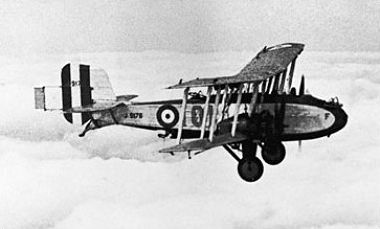- Boulton Paul Sidestrand
infobox Aircraft
name = Sidestrand
type =Bomber
manufacturer =Boulton Paul 
caption =
designer = H.A. Hughes
first flight =1926
introduced = 1928
retired = 1936
status =
primary user =Royal Air Force
more users =
produced =
number built = 20 (four Sidestrands were converted into theBoulton Paul Overstrand )
unit cost =
variants with their own articles =Boulton Paul Overstrand The Boulton Paul P.29 Sidestrand was a twin-enginebiplane medium bomber of theRoyal Air Force . Named after a village on theNorfolk coast near Boulton & Paul's factory inNorwich , the Sidestrand first flew in 1926 and entered service in 1928. It remained in service until 1936, only ever equipping one squadron;No. 101 Squadron RAF . It was an agile and relatively fast aircraft that was capable ofaerobatic manoeuvres such as loops, rolls and spins.Design and development
Only 20 Sidestrands were ever built. The first two, essentially prototypes, were designated the Sidestrand Mk I. Originally intended to be powered by two
Napier Lion inline engine s, the Mk I was eventually fitted with 425 hp (317 kW)Bristol Jupiter VIradial engine s which also powered the first six production Sidestrands, designated the Sidestrand Mk II. The remaining 12 aircraft were powered by 460 hp (343 kW) Jupiter VIIFs and were designated the Sidestrand Mk III. The six Mk IIs were also re-engined to bring them up to the Mk III specification.The Sidestrand had three open defensive gun positions; nose, dorsal and ventral. The crew usually consisted of three personnel; pilot, nose gunner and a single gunner for the dorsal or ventral positions, the choice depending on where each individual plane was intended to fly in a formation. Armament for each position was a single .303 in (7.7 mm)
Lewis gun . The Sidestrand's bombload was limited to 1,050 lb (476 kg) which did not compare favourably with its contemporaries such as theMartin B-10 .Operational history
Deliveries to the newly re-formed No. 101 Squadron at Bircham Newton began in 1928, the first batch of six aircraft being the Sidestrand Mk II with ungeared Bristol Jupiter VI engines. These were followed by nine of the Sidestrand Mk III variants with geared Jupiter VIII Fs, and the final three production aircraft were replacement Mk IIs. The squadron then moved to
RAF Andover in 1929.The Sidestrand inherited the good manoeuvrability of the Boulton Paul P. 7 Bourges, but despite proving to be an excellent aircraft for bombing and gunnery, only No. 101 Squadron was equipped. In the early 1930s a Sidestrand Mk III was fitted with
Bristol Pegasus IM3 engines. This was intended to become the Sidestrand Mk IV, but eventually became the prototype for the redevelopedBoulton Paul Overstrand which would begin replacing the Sidestrand in service in 1936. Four Sidestrands were eventually converted to Overstrand standard and essentially are considered Overstrands.Operators
; UK
*Royal Air Force
**No. 101 Squadron RAF pecifications (Mk III)
aircraft specifications
plane or copter?= plane
jet or prop?= prop
ref=Fact|date=January 2008crew= three or four (pilot and 2-3 gunners)
capacity=
length main= 46 ft
length alt= 14.02 m
span main= 71 ft 11 in
span alt= 21.92 m
height main= 14 ft 10 in
height alt= 4.52 m
area main= 979 ft²
area alt= 91 m²
airfoil=
empty weight main= 6,000 lb
empty weight alt= 2,726 kg
loaded weight main= 10,179 lb
loaded weight alt= 4,627 kg
useful load main=
useful load alt=
max takeoff weight main=
max takeoff weight alt=
more general=
engine (prop)=Bristol Jupiter
type of prop=9-cylinder air-cooledradial engine
number of props=2
power main=460 hp
power alt=343 kW
power original=
max speed main= 140 mph
max speed alt=122 knots, 225 km/h
max speed more=at 10,000 ft (3,050 m)
cruise speed main=
cruise speed alt=
never exceed speed main=
never exceed speed alt=
stall speed main=
stall speed alt=
range main=500 miles
range alt=435 nm, 805 km
ceiling main=24,000 ft
ceiling alt= 7,300 m
climb rate main=15,000 ft in 19 minutes
climb rate alt= 4,572 m
loading main= 10.4 lb/ft²
loading alt= 50.8 kg/m²
thrust/weight=
power/mass main= 0.09 hp/lb
power/mass alt= 148 W/kg
more performance=
guns=3 × .303 in (7.7 mm)Lewis gun s in nose, dorsal and ventral gun positions
bombs= 1,050 lb (476 kg) total
avionics=ee also
aircontent
related=
*Boulton Paul Overstrand
similar aircraft=lists=
*List of bomber aircraft see also=
References
Notes
Bibliography
* Brew, Alec. "Boulton Paul Aircraft since 1915". London: Putnam, 1993. ISBN 0-85177-860-7.
* Winchester, Jim. "Bombers of the 20th Century". London: Airlife Publishing Ltd., 2003. ISBN 1-84037-386-5.External links
* [http://avia.russian.ee/air/england/boulton_side.php Boulton-Paul Sidestrand 1926]
Wikimedia Foundation. 2010.
